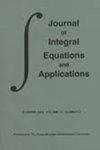Positivity of a weakly singular operator and approximation of wave scattering from the sphere
IF 0.9
4区 数学
Q2 MATHEMATICS
引用次数: 0
Abstract
We investigate properties of a family of integral operators B with a weakly singular compactly supported zonal kernel function on the surface S of the unit 3D sphere. The support is over a spherical cap of height h ∈ (0,2]. Operators like this arise in some common types of approximations of time domain boundary integral equations (TDBIE) describing the scattering of acoustic waves from the surface of the sphere embedded in an infinite homogeneous medium where h is directly related to the time step size. We show that the Legendre polynomials of degree `≥ 0 satisfy ∫ h 0 P̀ (1−z2/2)dz > 0 for all h∈ (0,2] and, using spherical harmonics and the Funk-Hecke formula for the eigenvalues of B, that this is a key to unlocking positivity results for a subfamily of these operators. As well as positivity results we give detailed upper and lower bounds on the eigenvalues of B and on ∫ S u(x)(Bu)(x) dx. We give various examples of where these results are useful in numerical approximations of the TDBIE on the sphere and show that positivity of B is a necessary condition for these approximation schemes to be well-defined. We also show the connection between the results for eigenvalues and the separation of variables solution of the TDBIE on the sphere. Finally we show how this relates to scattering from an infinite flat surface and Cooke’s 1937 result ∫ r 0 J0(z)dz > 0 for all r > 0.弱奇异算子的正性与球面波散射的近似
我们研究了在单位三维球面的表面S上具有弱奇异紧支撑带状核函数的一类积分算子B的性质。支撑在高度为h∈(0,2]的球面帽上。像这样的算子出现在时域边界积分方程(TDBIE)的一些常见类型的近似中,描述了声波从嵌入无限均匀介质中的球体表面的散射,其中h与时间步长直接相关。我们证明了对于所有h∈(0,2],阶`≥0的勒让德多项式满足Γh0PÉ(1−z2/2)dz>0,并且利用球谐函数和B的特征值的Funk-Hecke公式,这是解开这些算子的一个子族的正性结果的关键dx。我们给出了这些结果在球面上TDBIE的数值近似中有用的各种例子,并表明B的正性是这些近似方案被定义的必要条件。我们还展示了特征值的结果与球面上TDBIE的变量分离解之间的联系。最后,我们展示了这与来自无限平面的散射之间的关系,以及Cooke在1937年对所有r>0的结果ξr0J0(z)dz>0。
本文章由计算机程序翻译,如有差异,请以英文原文为准。
求助全文
约1分钟内获得全文
求助全文
来源期刊

Journal of Integral Equations and Applications
MATHEMATICS, APPLIED-MATHEMATICS
CiteScore
1.30
自引率
0.00%
发文量
16
审稿时长
>12 weeks
期刊介绍:
Journal of Integral Equations and Applications is an international journal devoted to research in the general area of integral equations and their applications.
The Journal of Integral Equations and Applications, founded in 1988, endeavors to publish significant research papers and substantial expository/survey papers in theory, numerical analysis, and applications of various areas of integral equations, and to influence and shape developments in this field.
The Editors aim at maintaining a balanced coverage between theory and applications, between existence theory and constructive approximation, and between topological/operator-theoretic methods and classical methods in all types of integral equations. The journal is expected to be an excellent source of current information in this area for mathematicians, numerical analysts, engineers, physicists, biologists and other users of integral equations in the applied mathematical sciences.
 求助内容:
求助内容: 应助结果提醒方式:
应助结果提醒方式:


